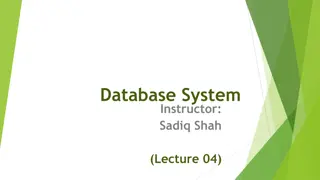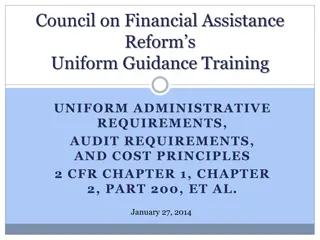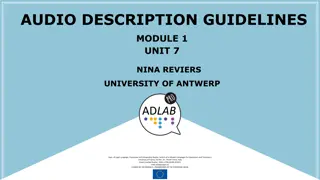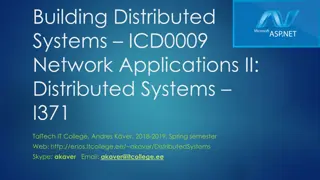Understanding Nomen Entity in RDA Training Module
Explore the development of the Nomen entity in RDA training, differentiating nomen and nomen strings, identifying RDA elements for describing a nomen, and examining relationship elements linking RDA entities with nomens. Delve into the origins and attributes of nomens as defined in FRBR and FRAD sta
1 views • 48 slides
Progressive Approach to Relational Entity Resolution
In this research paper authored by Yasser Altowim, Dmitri Kalashnikov, and Sharad Mehrotra, a progressive approach to relational entity resolution is presented. The study focuses on balancing cost and quality in entity resolution tasks for relational datasets. The goal is to develop a method that ac
1 views • 20 slides
knmindia-as-domestic-entity
\nAT ONE GLANCE\nAs Domestic Entity\n\/\/knmindia.com\/wp-content\/uploads\/2021\/03\/Joint-Ventures.png\nFind out more\nWOS or JVC\nWOS or JVC in India can be incorporated as a Private Limited Company or a Public Limited Company.\n\/\/knmindia.com\/wp-content\/uploads\/2021\/03\/LLP.png\nFind out m
0 views • 1 slides
Understanding Relational Database Design and Mapping Techniques
Explore the process of mapping Entity-Relationship (ER) and Enhanced Entity-Relationship (EER) models to relational databases. Learn about relational model concepts, mapping algorithms, and the goals and steps involved in the mapping process. Discover how to preserve information, maintain constraint
3 views • 42 slides
Knowledge Graph and Corpus Driven Segmentation for Entity-Seeking Queries
This study discusses the challenges in processing entity-seeking queries, the importance of corpus in complementing knowledge graphs, and the methodology of segmentation for accurate answer inference. The research aims to bridge the gap between structured knowledge graphs and unstructured queries li
0 views • 24 slides
Differences Between Statutory Crown Entity Boards and Commercial or NGO Boards
Statutory Crown entity boards differ from commercial or NGO boards in terms of ministerial influence, funding limitations, public scrutiny, and government standards. The responsible Minister has more interaction, and boards have limited discretion in funding and pricing adjustments. Crown entities f
1 views • 19 slides
Understanding Entity-Relationship Modeling in Database Systems
Explore the concept of Entity-Relationship Modeling in Database Systems through examples like the E-R Model, E-R Diagrams, and Business Rules. Learn about entities, relationships, attributes, and cardinalities to design efficient databases.
0 views • 18 slides
How to Check Status in SAM.gov
SAM.gov is a crucial site for checking the status of registrations and validations. Once logged in, users can visit the workspace to monitor their status daily, apply, or renew. The process involves validating entities, obtaining a Unique Entity ID, entering core data and assertions, completing Reps
0 views • 8 slides
Understanding Entity-Relationship Model in Database Systems
This article explores the Entity-Relationship (ER) model in database systems, covering topics like database design, ER model components, entities, attributes, key attributes, composite attributes, and multivalued attributes. The ER model provides a high-level data model to define data elements and r
0 views • 25 slides
Understanding Semantic Roles in Sentence Structure
Semanticists analyze sentences based on semantic structure rather than traditional syntactic terms like subject and object. Instead, they use semantic terms such as Agent, External causer, Instrument, Affected, Recipient, and Locative. These terms help describe how people and things participate in r
1 views • 26 slides
Data Modeling Using the Entity-Relationship (ER) Model
This chapter discusses data modeling using the Entity-Relationship (ER) model, covering concepts such as entities, attributes, relationships, and database design processes. It outlines the design process, entity types, value sets, key attributes, weak entities, and more. The chapter also provides an
0 views • 57 slides
Understanding Integrity Constraints in Relational Database Systems
Integrity constraints play a crucial role in maintaining the accuracy and integrity of data in a database. They include domain constraints, entity integrity, and referential integrity, each serving a specific purpose to ensure data consistency and reliability. Domain constraints ensure values in a c
1 views • 12 slides
Understanding Entity-Relationship Diagrams (ERD) for Database Design
Entity-Relationship Diagrams (ERD) are vital in database design, illustrating entities and their relationships. They help in conceptualizing data models and laying the groundwork for database structures. The process involves identifying entities, defining relationships, and analyzing interactions to
0 views • 40 slides
Understanding Modeling Entities and Attributes in Database Systems
Entities, relationships, and attributes are fundamental constructs in the Entity-Relationship (E-R) model. Entities represent people, places, objects, events, or concepts in a user environment. Each entity type has a set of attributes defining its properties. It is crucial to distinguish between ent
2 views • 17 slides
Introduction to Entity Core Framework in C# and EF
Entity Core Framework is a powerful ORM tool that integrates C# classes with relational database tables, enabling seamless interaction between application code and database. It simplifies database operations, supports code-first and data-first approaches, and automates SQL query generation. Its appl
0 views • 6 slides
Unified Volunteering Platform: Host Entity Account Management Training Update
Explore the recent updates in the Unified Volunteering Platform focusing on Host Entity account management training, webinars for UN Host Entities, and the launch of new self-service features. Learn about the roles within Host Entity accounts and the transition to the new system. Contact support for
0 views • 7 slides
Importance of Job Description and Job Specification in Job Analysis
Job description and job specification are essential components of job analysis, providing crucial data for HR managers to understand job requirements and find the right candidate. While not legal requirements, they play a vital role in recruiting, selecting, and placing employees effectively. Job de
0 views • 6 slides
Understanding Entity-Relationship Diagrams (ERD)
An Entity-Relationship Diagram (ERD) is a vital data modeling technique for visualizing an information system's entities and their relationships. This graphical representation helps in database design by defining entities, analyzing interactions, and determining cardinality. Entities represent real-
1 views • 40 slides
Understanding Entity-Relationship Modeling in Database Systems
Entity-Relationship (ER) modeling is a crucial aspect of designing database systems. It helps in defining data elements and relationships, presenting a conceptual view of the database structure. Entities, attributes, key attributes, composite attributes, and multivalued attributes play distinct role
1 views • 33 slides
Understanding Basic Partnership Tax Law
Explore the fundamentals of partnership taxation according to the Tax Law Section of the Sacramento County Bar Association. Learn about the definition of a partnership, individual versus entity taxation, entity classification rules, and the different types of partnerships for tax purposes.
0 views • 51 slides
Entity-based Memory Network for Text Comprehension
Entity-based Memory Network is a model designed for text comprehension, focusing on question-answering tasks in both open and closed domain QA. It incorporates features like distributed representation, feature modeling, and memory models at various levels to generate output features, predict answers
0 views • 17 slides
Entity Resolution Problem in Customer Data Matching
The challenge of entity resolution, especially in the context of matching customer data between companies, is addressed in this content. The scenario involves accurately identifying which records correspond to the same individuals despite potential variations or errors in the data. Strategies such a
1 views • 56 slides
Recent Advances in Crowdsourced Entity Matching Problems
Recent research highlights the use of crowdsourcing in entity matching problems, aiming to improve accuracy and efficiency. The study investigates the challenges faced in scaling crowdsourced solutions for large enterprises and explores the limitations of developer-dependent workflows. The need for
0 views • 20 slides
Advancing Coreference Resolution: Transfer Model by Patrick Xia and Benjamin Van Durme
Coreference resolution models are crucial for identifying spans of text referring to the same entity. Explore the advancements in coreference resolution, including dataset differences, annotation types, and domain variations through the work of Patrick Xia and Benjamin Van Durme. Dive into the compl
0 views • 23 slides
Reforms to Administrative Requirements under Uniform Guidance Training
The Council on Financial Assistance Reform's Uniform Guidance Training focuses on changes to administrative requirements, audit requirements, and cost principles under 2 CFR Chapter 1, Chapter 2, Part 200, and more. Major changes include updates to Circular A-102, A-110, and A-89 affecting grants, c
0 views • 62 slides
Exploring the Art of Descriptive Writing
Descriptive writing aims to immerse readers in a sensory experience by vividly portraying people, places, or things through carefully chosen details. Description paragraphs should focus on action over sensations, providing essential information in a clear, detailed, and chronological manner. The ele
0 views • 5 slides
Fundamentals of Relational Databases in CSCE 315 - Lecture Highlights
Introduction to relational databases covering topics such as relational data model, schemas, converting from entity-relationship model, entity sets, relations, relationships, combining relations, and practical examples. Learn about storing data in tables, attributes, database organization, and the i
1 views • 18 slides
Audio Description Guidelines in Modern Languages for Translators and Interpreters
Explore the various types and importance of audio description guidelines, covering topics like what to describe, when and how to describe, and dealing with thorny issues such as subjectivity and film techniques. Discover the differences between general approaches and strategies, along with examples
0 views • 17 slides
Understanding Entity Framework in C# for Database Management
Entity Framework in C# offers a powerful ORM solution for data manipulation and database management. It allows developers to work with databases in an object-oriented manner, simplifying the handling of database operations. Learn about ORM, Code First approach, conventions, DbContext usage, and data
0 views • 21 slides
Understanding Object-Relational Mapping and Entity Framework in Distributed Systems
Explore the concepts of Object-Relational Mapping (ORM), Entity Framework (EF), and Fluent Interface in the context of building distributed systems. Learn about ORM implementations, SQL generation, EF versions, database design approaches, and the use of fluent APIs to enhance readability in code.
0 views • 45 slides
Knowledge Graph Completion Model Integrating Entity Description and Network Structure at EEKE2021
EEKE2021 presented a model that integrates entity description and network structure to enhance knowledge graph completion (KGC). The model aims to predict missing information in the graph by considering various sources of data beyond the traditional triple structure. It discusses related work, resea
0 views • 22 slides
Efficient Entity Framework Operations for Database Management
Learn how to efficiently manage data in Entity Framework by adding, updating, and deleting entities with ease. Discover how to perform multiple operations in a single transaction, handle related data effectively, and optimize database interactions.
0 views • 15 slides
Automated Knowledge Base Construction: Taxonomy Induction and Entity Disambiguation Overview
Explore the foundations of automated knowledge base construction through taxonomy induction and entity disambiguation frameworks. Learn about organizing and distinguishing entity types, the significance of structuring entities like physicists, villages, and chemical formulas. Delve into the inputs,
0 views • 53 slides
Understanding Liability of Individuals in Maine Business Entities
Maine business entities, including corporations and LLCs, offer limited liability protections for owners and managers. Shareholders of corporations are not personally liable for the entity's debts, except in specific circumstances. Similarly, members and managers of LLCs are not personally obligated
0 views • 32 slides
Registered Agents Requirement for Business Entities in Colorado
Colorado law requires every domestic and foreign business entity operating in the state to maintain a registered agent. This agent can be an individual, a domestic entity, or a foreign entity with a place of business in Colorado. The registered agent is authorized to receive legal documents and noti
0 views • 9 slides
Trie-based Entity Extraction Framework for Dirty Real-World Data
Researchers from Tsinghua University, China, have developed a Trie-based framework for entity extraction in real-world data, addressing challenges such as dirty data and typos in author names and titles. The framework leverages Trie-based algorithms to optimize partition schemes and extract named en
0 views • 56 slides
Understanding Entity-Relationship Model in Databases
The Entity-Relationship Model (E/R Model) is a widely used conceptual data model proposed by Peter P. Chen. It provides a high-level description of the database system during the requirements collection stage. Entities represent things of independent existence, each described by a set of attributes.
0 views • 21 slides
Entity-specific Rankings of Knowledge Base Properties
Towards entity-specific rankings of knowledge base properties, this research explores the problem of property ranking for entities based on their attributes and properties. Various applications in knowledge base curation and natural language generation are discussed, along with related work in entit
0 views • 26 slides
Debugging Blocker in Entity Matching using MatchCatcher
Explore how the MatchCatcher solution helps identify and improve matches killed off by blockers in the entity matching process. The solution allows users to quickly find and analyze these matches, enhancing the efficiency of the blocking stage in entity matching.
0 views • 24 slides
Understanding Job Analysis and Job Description
Job analysis, as defined by Edwin Flippo, is the process of studying and collecting information about the operations and responsibilities of a specific job. This crucial task involves various components such as creating a detailed job description outlining the job title, qualifications, and more. En
0 views • 14 slides







































